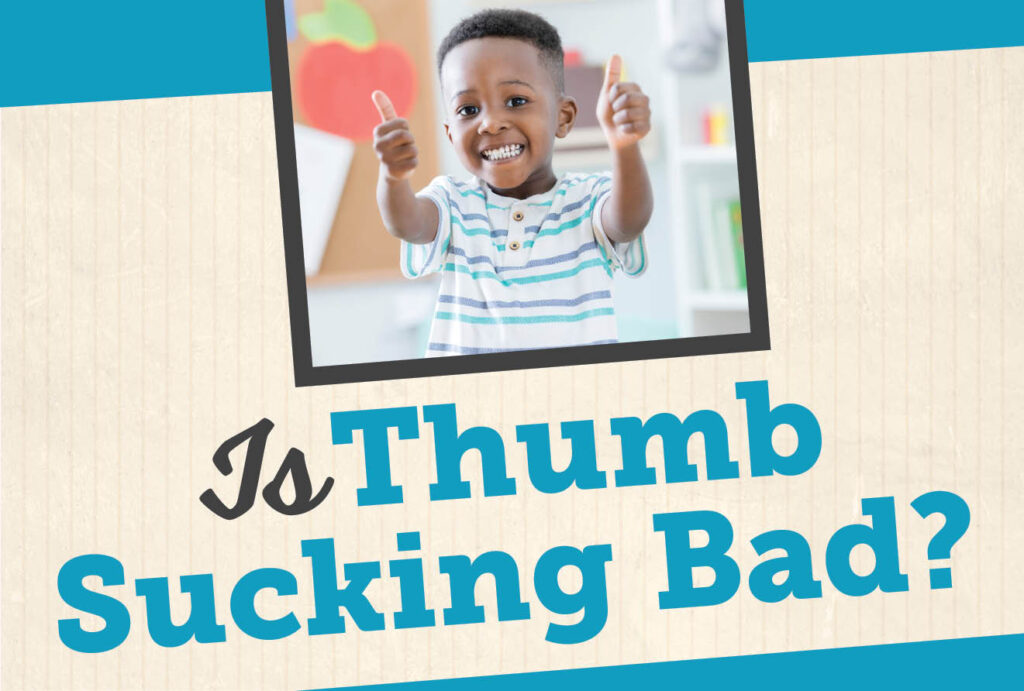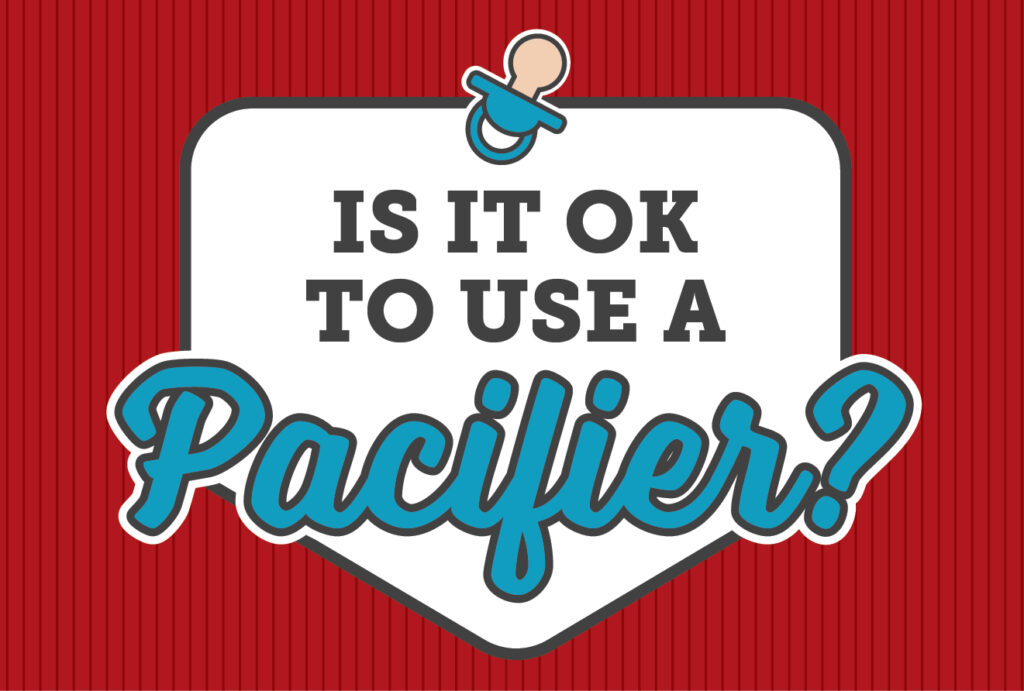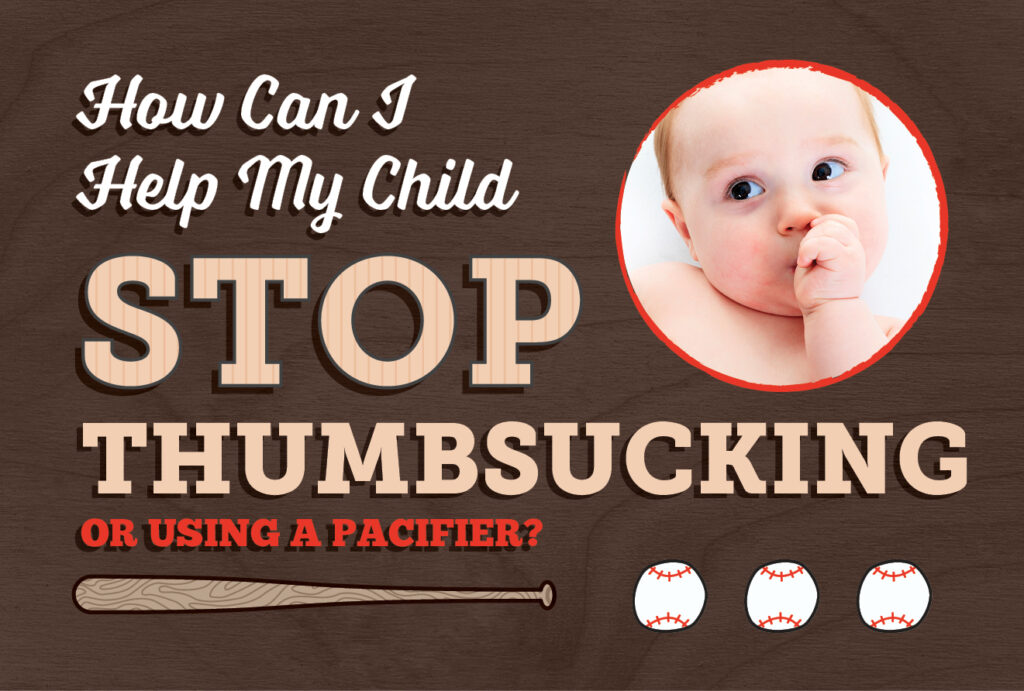September 29th, 2021

Is Thumb Sucking Bad?
Sucking is a natural reflex. Infants and young children may use thumbs, fingers, pacifiers, and other objects on which to suck. It may make them feel secure and happy or provide a sense of security during difficult periods. Since thumb-sucking is relaxing, it may induce sleep.
Most thumb-sucking that persists for long periods of time can cause problems with the proper growth of the mouth and tooth alignment. How intensely a child sucks on fingers or thumbs will determine whether or not dental problems may result. Children who rest their thumbs passively in their mouths are less likely to have difficulty than those who vigorously suck their thumbs.
Usually, children stop between the ages of two and four. Sometimes, peer pressure causes many school-aged children to stop. Children should try to stop thumb-sucking by about age three to prevent flaring of their permanent teeth.
Pacifiers are no substitute for thumb-sucking. They can affect the teeth essentially the same way as sucking fingers and thumbs. However, use of the pacifier can be controlled and modified more easily than the thumb or finger habit. If you have concerns about thumb sucking or use of a pacifier, consult with your pediatric dentist.
A few suggestions to help your child get through thumb sucking:
- Children often suck their thumbs when feeling insecure. Focus on correcting the cause of anxiety, instead of the thumb-sucking.
- Reward children when they refrain from sucking during difficult periods, such as when being separated from their parents.
- Your pediatric dentist can encourage children to stop sucking and explain what could happen if they continue.
- Consider using a sticker chart, or one of our coloring sheets to help encourage cessation of the habit.
- If these approaches don’t work, remind the children of their habit by bandaging the thumb or putting a sock on the hand at night. Sometimes, your pediatric dentist may recommend the use of a mouth appliance.
Visit our blog for more tips on how to help your child beat thumb-sucking and pacifiers.
August 31st, 2021

Most children often suck on fingers, thumbs, pacifiers, and other objects as a way to calm themselves. Sucking, a natural reflex, helps children feel happy and provides a sense of security, especially during stress. Because it is calming, sucking can relax a child to sleep.
Prolonged pacifier use, or thumb-sucking, can cause orthodontic problems such as open bites, crossbites, and flared front teeth. Pacifier usage is often an easier habit to break in a child. For this reason, if your child begins to develop a consistent sucking habit, we recommend that you encourage your infant away from thumbs (or fingers) and towards a pacifier.
Remember to keep pacifiers clean and sterilized often to avoid infections or bacterial growth.
What types of pacifiers are okay?
There are many types of pacifiers, but they are not all equal. Make sure you look for an orthodontic pacifier which is flattened on the bottom and rounded on top. This reduces pressure on the gums and allows the baby's tongue to move naturally. Additionally, heavier pacifiers, like those with a stuffed animal attached, tend to cause more flaring of the teeth due to the pressure from the weight.
Changing your child's habits
- Only let your child have their pacifier at bedtime or to calm them down when upset.
- Remove the pacifier from their mouth when they are playing or watching TV and gently remind your child it is for bed time. Don't let them walk around with it in their mouth.
- Often children will use a pacifier or suck their thumb while snuggling a comfort item, like a special blanket or stuffed animal. Try to limit access to the comfort item if necessary.
- Make it fun! Remember positive reinforcement is a great way to encourage kids to change their habits. Check out our free printable calendar and coloring sheets.
Click here for additional tips on how to help your child stop using a pacifier, or thumb-sucking.
Tags: Early Infant Oral Care, Infant Oral Care, Thumbsucking, Thumb Sucking, pacifiers
Posted in Infant Oral Care, Preventative Care, Thumbsucking, Toddlers, Healthy Mouths, Baby Care, Thumb Sucking | No Comments
April 15th, 2020

Did you know that when a child sucks on a thumb, fingers, or pacifier, it can negatively impact his/her dental health? While it is common for little ones to suck their thumbs, prolonged thumbsucking and pacifier use can cause orthodontic problems such as open bites, crossbites, and flared front teeth.
First steps to changing the habits:
- Limit thumbsucking or pacifier use to bedtime only or when your child is upset.
- Do not allow your child to carry the pacifier around in their mouth when they are playing or watching TV.
- If your child engages in the habit when they have a special blanket or stuffed animal with them, try to remove the comfort item.
- Make it fun: remember that positively reinforcing the habits you want is a great way to encourage kids as they give up their old habits.
Check out some ideas below:
For thumb/finger sucking:
- Use a sticker chart to track progress. If your child is able to go a period of time without sucking his/her thumb or finger, he/she can earn a sticker. After a certain number of stickers, he/she may earn a special outing or present. Earlier in the process, some children may need to earn multiple stickers per day to keep the motivation up. As time progresses, you can work towards longer intervals. You know your child child. Think about what would motivate them. Check out grandslamsmiles.com for a free printable calendar and coloring sheets.
- Put a band-aid on your child’s thumb/finger every morning to help him/her remember not to suck it. We recommend using this only during the waking hours to prevent accidentally swallowing the band-aid while asleep. Pick out fun band-aids at the store together!
- Try the T-Guard or Finger Guard, a plastic case that covers the thumb or finger and has a bracelet so it cannot easily be removed. This can be ordered online.
- Try Mavala Stop, a bitter tasting liquid which is painted on the thumb or finger. This is not meant to be punishment but a gentle reminder.
- If these strategies do not work, talk with your dentist about an orthodontic appliance. These appliances are usually only used when a child is ready to stop but is having a hard time with other strategies.
For pacifier use:
- Start by limiting use to nap time and bedtime only, or when your child is upset.
- Leave the pacifier for the “pacifier fairy.” We hear that she leaves fun surprises!
- Cut the nipple over time, making it shorter and shorter. (Note: make sure that the pacifier is in one piece and not a choking hazard.)
- Take to Build A Bear and put it inside the bear!
- Leave the pacifier for Santa Claus to take to the baby elves, or the stork to give to the new baby sibling or family member!
- Cut it out “cold turkey.” Most children have a few rough nights but adjust better than parents think.




